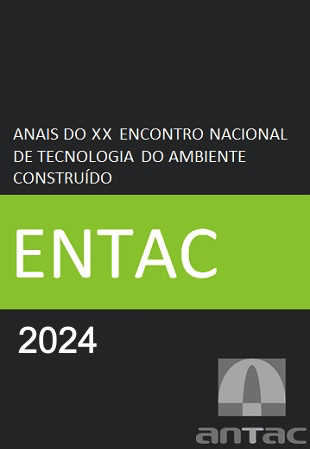Analysis of circadian light in the retrofit of artificial lighting in a university building
DOI:
https://doi.org/10.46421/entac.v20i1.5848Keywords:
Artificial lighting, Circadian rhythm, Circadian light, Computational simulation, ALFAAbstract
The discovery of intrinsically photosensitive retinal ganglion cells (ipRGC) has confirmed the impact of light on the circadian rhythm and alertness levels in humans. This discovery has led to the development of metrics to assess the non-visual effects of light. The WELL Certification, in its "Circadian Lighting Design" topic, states that a minimum 275 Equivalent Melanopic Lux (EML) should be achieved for at least 4 hours at workstations during the day, with electric lighting being permissible to meet this metric. The objective of this study was to analyze the retrofit design of the artificial lighting system in a higher education classroom in terms of its circadian potential. This design aimed to improve visual comfort, energy efficiency, and compliance with NBR ISO/CIE 8595:2013, without considering the circadian potential of light during its development. Therefore, computational simulation was conducted using the ALFA tool to analyze the melanopic/photopic ratio (M/P) and the EML metric. The M/P ratio yielded neutral results for all simulated conditions. None of the tested luminaires achieved 275 EML in 100% of the viewing directions.
References
LO VERSO, V. R. M.; GIULIANI, F.; CAFFARO, F.; BASILE, F.; PERON, F.; DALLA MORA, T.; BELLIA, L.; FRAGLIASSO, F.; BECCALI, M.; BONOMOLO, M.; NOCERA, F.; COSTANZO, V. Questionnaires and simulations to assess daylighting in Italian university classrooms for IEQ and energy issues. Energy and Buildings, v. 252, p. 111433, dez. 2021. DOI: https://doi.org/10.1016/j.enbuild.2021.111433
LLINARES, C.; CASTILLA, N.; HIGUERA-TRUJILLO, J. L. Do Attention and Memory Tasks Require the Same Lighting? A Study in University Classrooms. Sustainability, v. 13, n. 15, p. 8374, 27 jul. 2021. DOI: https://doi.org/10.3390/su13158374
DOULOS, L.T.; KONTADAKIS, A.; MADIAS, E.N.; SINOU, M.; TSANGRASSOULIS, A. Minimizing energy consumption for artificial lighting in a typical classroom of a Hellenic public school aiming for near Zero Energy Building using LED DC luminaires and daylight harvesting systems. Energy and Buildings, v. 194, p. 201–217, jul. 2019. DOI: https://doi.org/10.1016/j.enbuild.2019.04.033
BELLIA, L; PEDACE, A; BARBATO, G. Lighting in educational environments: an example of a complete analysis of the effects of daylight and electric light on occupants. Building and Environment, v. 68, p 50–65, 2013. DOI: https://doi.org/10.1016/j.buildenv.2013.04.005
RU, T.; KOMPIER, M.E.; CHEN, Q.; ZHOU, G.; SMOLDERS, K. C. H. J. Temporal Tuning of Illuminance and Spectrum: Effect of a Full-Day Dynamic Lighting Pattern on Well-Being, Performance and Sleep in Simulated Office Environment. Building and Environment, v. 228, 2023. DOI: https://doi.org/10.1016/j.buildenv.2022.10984
KOMPIER, M.E.; SMOLDERS, K. C. H. J.; KRAMER, R. P.; MARKEN LICHTENBELT, W. D. van; KORT, Y. A. W. de. Contrasting Dynamic Light Scenarios in an Operational Office: Effects on Visual Experience, Alertness, Cognitive Performance, and Sleep. Building and Environment, v. 212, 2022. DOI: https://doi.org/10.1016/j.buildenv.2022.108844
FIGUEIREDO, E. C. D. Abordagem do ritmo circadiano no projeto de iluminação natural em edifícios de escritórios. Revista Sítio Novo, v. 7, p. 83, 28 mar. 2022. DOI: http://dx.doi.org/10.47236/2594-7036.2022.v7.i0.83-98p
IWBI. International WELL Building Institute. WELL v2. Circadian Lighting Design. 2024. Available at: https://v2.wellcertified.com/en/wellv2/light/feature/3. Acces in: fev. 2024.
MILLER, N.J.; IRVIN, A.L. M/P ratios – Can we agree on how to calculate them? IES: Illuminating Engineering Society, [S.I.], 27 set. 2019. Avaiable in: https://bit.ly/2RmXqIF. Access: 05 abr. 2024.
REVIT NEWS. ALFA – Um novo software de design de iluminação circadiana. Disponível em: https://www.revit.news/2018/06/alfa-a-new-circadian-lighting-design-software/. Acesso em 13 maio 2024.
NOOR, M. C.; SARADJ, F. M.; YAZDANFAR, S. A. Analytical Evolution of Measurement Methods for Light's Non-Visual Effects. Results in Engineering, v. 17, 2023. DOI: https://doi.org/10.1016/j.rineng.2023.100922
BELLIA, L.; BŁASZCZAK U.; DIGLIO, F.; FRAGLIASSO, F. Assessment of Melanopsin-Based Quantities: Comparison of Selected Design Tools and Validation against on-Field Measurements. Building and Environment, v. 232, 2023. DOI: https://doi.org/10.1016/j.buildenv.2023.110037
PIERSON C.; AARTS, M.; ANDERSEN, M. Validation of spectral simulation tools for the prediction of indoor daylight exposure. Proceedings of the Conference CIE 2021, 2021, Bruges, Belgium, 1–3 September, 2021.
MONTEIRO, L. A; AVELAR, P. R.; PADILHA, D. B.; MEDEIROS, H. G.; SOUZA, R. V. G. Sistema de iluminação do CAD 3 - análise pela INI-C para retrofit. In: Encontro Nacional de Tecnologia do Ambiente Construído, 19., 2022, Canela. Anais [...] Porto Alegre: ANTAC, 2022. P. 1-11. DOI: https://doi.org/10.46421/entac.v19i1.2152
YANG, W.; JEON, J.Y. Effects of Correlated Colour Temperature of LED Light on Visual Sensation, Perception, and Cognitive Performance in a Classroom Lighting Environment. Sustainability 2020, 12, 4051. https://doi.org/10.3390/su12104051
SOLEMMA LLC. ALFA Adaptive Lighting for Alertness - A new circadian lighting design software. 2024. Available at: https://www.solemma.com/alfa. Access in: 20 abr. 2024.
COSTA, J. F. W.; AMORIM, C. N. D.; SILVA, J. C. R. Envidraçamento Eletrocrômico e Avaliação dos Efeitos Visuais e Não Visuais da Luz Natural: Estudos de Simulação para Brasília – Brasil. Journal of Daylighting, V. 11, p. 1-22, 2024. DOI: https://dx.doi.org/10.15627/jd.2024.1

